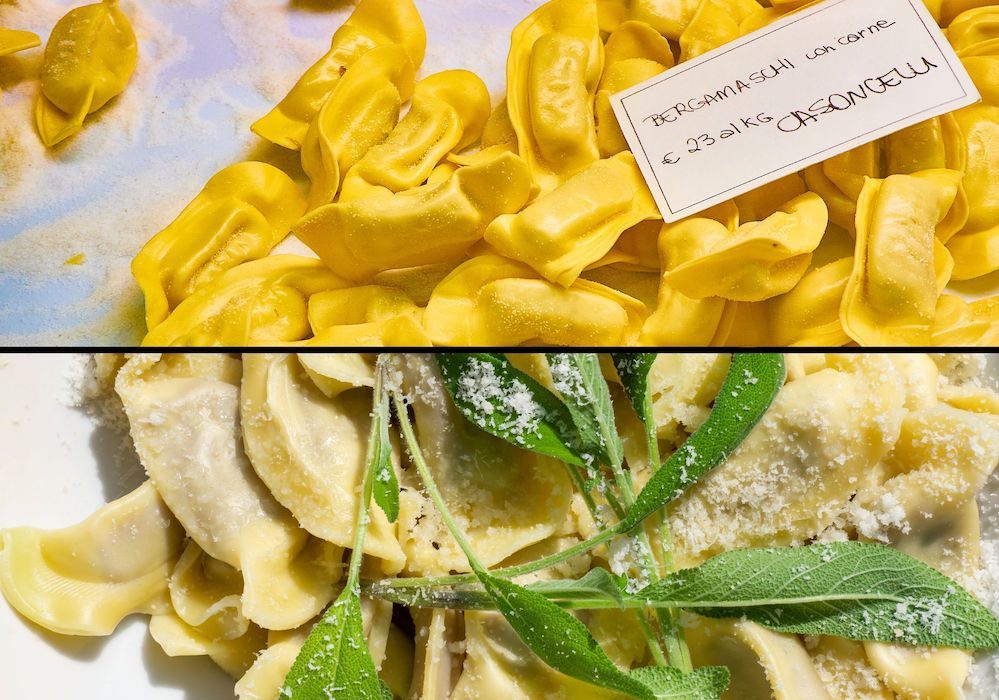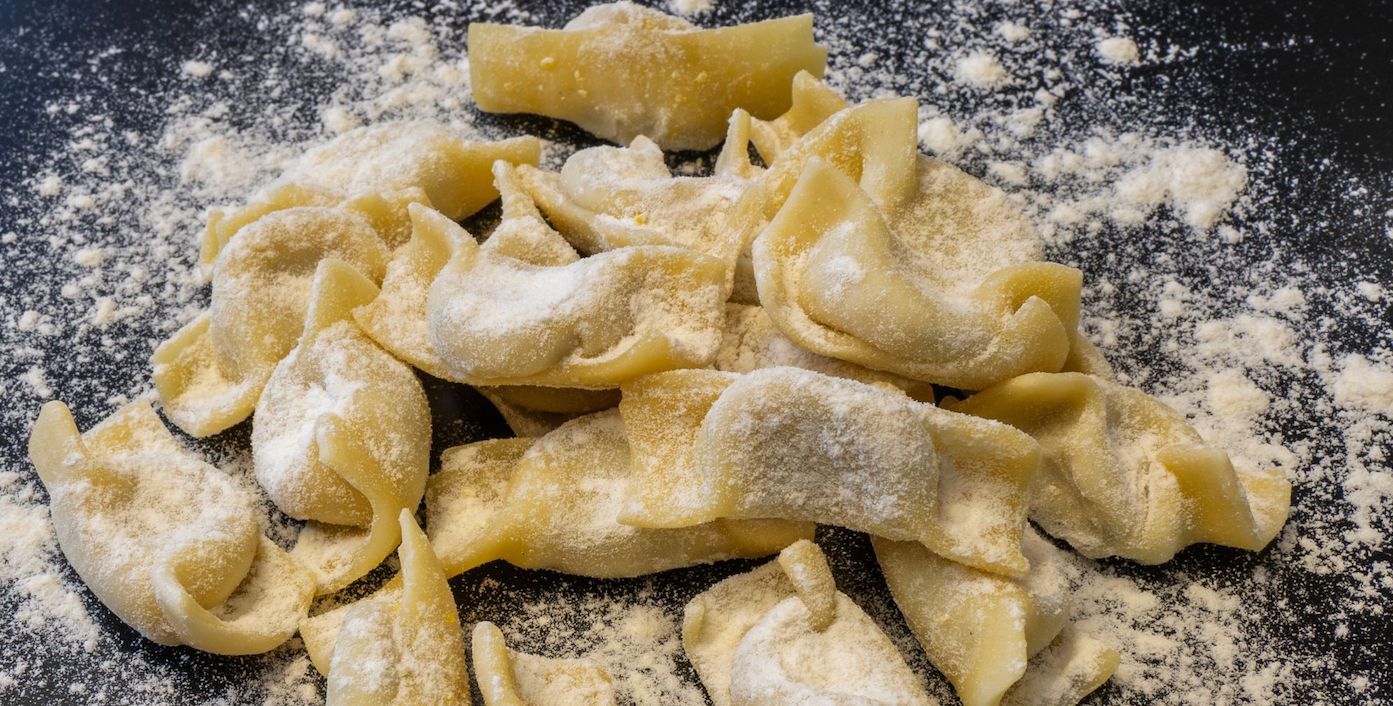Which is the correct way to cook casoncelli? What are the ingredients we need to use to prepare this traditional Lombard recipe? It’s not so simple to give a precise answer to these questions, on one hand because we are talking about a dish that is typical, but may also present many local variations, especially among the mountain valleys of the provinces of Bergamo and Brescia.
In addition, Bergamo and Brescia, so rich in history and art and united as the Italian Capital of Culture 2023, are two historically rival cities, also in terms of gastronomic traditions. So let’s find out how Bergamo-style casoncelli differ from the ones from Brescia, and what procedure we must follow to make (and taste) this dish, which is only apparently poor, but actually rich in flavor and extraordinarily complex.

How to cook casoncelli: the (not only) culinary rivalry between Bergamo and Brescia

Beregamo-style casoncelli vs Brescia style casoncelli
In 2023 Bergamo and Brescia joined as the Italian Capital of Culture, but the two Lombard cities certainly do not have a history of fraternal friendship behind them. Their rivalry has ancient roots, dating back to the 12th century, when for reasons of territorial disputes the two municipalities fought real battles.
Only in 2020, in the most dramatic period of the Covid pandemic, the two Communes buried the hatchet and joined in a metaphorical embrace to try to recover together. Their message is beautiful, but it does not cancel the city competition in some traditional sectors, such as food.
Casoncelli (called in local dialect casonsèi) are in fact a type of egg pasta half-moon shaped typical of both Bergamo and Brescia. Each city offers a particular variation of the recipe, of which the people of Bergamo and Brescia are very jealous.
The version of casoncelli that we can find in Bergamo and its province comes with a thicker dough and a filling of veal and cheese. Everything is seasoned with butter, Grana Padano, sage and bacon.
In Brescia-style casoncelli, instead, we can notice how the filling is decidedly more delicate, composed of breadcrumbs, butter and Grana Padano. The dough has a thinner structure, in order to enhance the flavor of the filling, and there is no use of bacon in the dressing.
Traditions and secrets of casoncelli
Casoncelli are a very ancient recipe, dating back to the medieval period. Originally the filling did not involve the use of meat, and also eggs and flour had great value in that historical period. That’s why farmers prepared this dish exclusively during holidays, a tradition carried on substantially until the 20th century.
In fact there is a proverb that says: "chèi che 'mpasta i casonsèi i maia föra la casa è i tèmpiei" ("those who knead the casoncelli squander their goods").
As we said, in addition to those of Bergamo and Brescia there are other local variations of the recipe, for example that of Valcamonica, which uses many herbs such as spinach or savoy cabbage; the giant casoncelli of Artogne, in the province of Brescia; or those with salami, potatoes and nutmeg.
We can find casoncelli for all tastes, united by their delicious flavour, and by the ability to restore travelers returning from a tiring journey through the paths of the Orobie Alps or the Brescia valleys.
Let’s find out the ingredients and the process to cook casoncelli to perfection
First, we can start our process to cook casoncelli looking at the ingredients we need for the preparation of the dough (portion for 4 people):
- Soft wheat flour "00", 280 g
- Durum wheat, 100 g
- 2 eggs
- Water
- Salt
Then, for the filling, we'll have to use:
- Breadcrumbs, about 60 g
- 1 egg
- Salami paste, 150 g
- 1 clove of garlic
- 1 tuft of chopped parsley
- Grana Padano grated, 40 g
- Salt
- Pepper
- Nutmeg
With the addition, for the version of the casoncelli Bergamaschi, of 100 g of roast meat; while some local variations also use macaroons (5 or 6) and raisins (10 g), to make casoncelli sweeter.
Finally, for the dressing:
- Butter, 100 g
- Grana grated, 100 g
- Sage
- 100 g of bacon for Bergamo-style casoncelli, not used in the version of Brescia.
The process is quite simple: mix the flour with the eggs and durum wheat, adding water and salt and making a well-blended and homogeneous mixture, which will then rest for about a couple of hours.
In the meantime we can dedicate ourselves to the preparation of the filling, browning in butter the salami paste and then adding the roast meat (if the version of casoncelli that we are preparing requires it, of course), with garlic and parsley that will help us increase the flavor. Then pour everything into a bowl and mix it with parmesan, eggs, breadcrumbs, salt and pepper, as well as (optionally) crumbled amaretti and minced raisins.
Once the filling is ready and the dough has rested, we recover the latter and roll it out, remembering that to reproduce the typical casoncelli of Brescia we’ll have to pull the dough particularly thin. Then we cut out some disks of about 6 cm, fill them with the stuffing and close them by folding the edge and lowering a little the center, so as to reproduce the classic half-moon shape.
Now our casoncelli are ready: it only remains to cook them for a few minutes (about 6 to 8) and season them with grated Grana Padano cheese and sage, with the addition of bacon for the traditional variant of Bergamo.
Finally we can sit at the table and enjoy the simple and genuine flavors of the historic Lombard recipe of casoncelli!
About the author
Written on 04/07/2023



Alessandro Savino
How to cook casoncelli? Discover the secrets of this tasty recipe, source of a gastronomic rivalry between the cities of Bergamo and Brescia.